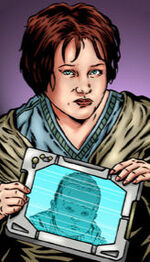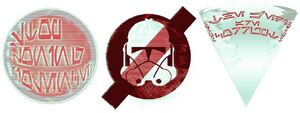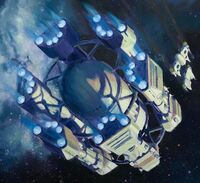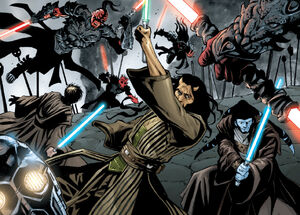| | |
Aristocra Chaf'orm'bintrano has often stated that the Jedi are honored and admired by all. Apparently, he was mistaken.Prard'ras'kleoni

Anti-Jedi sentiments centered around fear, mistrust, envy, or outright hatred of the Jedi Order. Just as with the Sith, many sentients of the galaxy feared them, and criticism developed from the fact that many common people did not understand the Jedi, their ability to use the Force, or their principles. Many of those outside of the Force equated them with the Sith and did not find them any better. The Jedi propensity for taking children away from their families at birth generated a large amount of controversy, with the last major example being the "Baby Ludi" case. Due to the Order's alignment with the Republic and the Jedi's role as mediators and negotiators, those living outside the Republic saw them merely as puppets of the Republic.
History
Anti-Jediism was normally quite prevalent during times of conflict, especially when the Order was a particular _target of the enemy force attacking the Galactic Republic.
Old Republic era
The Jedi... the Sith... you don't get it, do you? To the galaxy, they're the same thing; just men and women with too much power, squabbling over religion, while the rest of us burn.Atton Rand
After the end of the Jedi Civil War, many people began to loathe the Jedi as much as the Sith, as they believed they were equally responsible for the destruction brought upon the galaxy. Many would willingly turn in a Jedi to the Exchange, who had put a bounty out on them. Five years after the war's end, one refugee on Nar Shaddaa even remarked to Meetra Surik that "Sith" and "Jedi" were "two different words for the same thing."
During New Sith Wars, in times of crisis, despite their noble intentions and scrupulous behavior of the several Jedi who served as Republic Supreme Chancellor, the general public was never entirely convinced that these leaders had won their elections fairly and came to regard the Jedi as the most powerful power-mongers. Such distrust fueled the fact that the Jedi Order, in a desperate attempt, recruited Force-sensitive children to fight in the Battle of Ruusan.[3]
Rise of the Empire era
But killing a Jedi? Ah, now that makes you dangerous. You'd be surprised at the status that gives you. How many sentients really hate Jedi.Lyshaa

In the final years of the Galactic Republic, many Senators did not trust the Jedi—a sentiment of distrust, however, that many Jedi reciprocated for the Senators. A few years prior to the outbreak of the Clone Wars, Jedi-shamed[5][6][7][8] Senators Sano Sauro and Bog Divinian, along with Jedi-deposed[9] Romin tyrant Roy Teda, tried to stir up anti-Jedi sentiment in the Senate by proposing that the monastic Order should be precluded from all future activities of the Senate. The anti-Jedi faction's claims did little, however, towards achieving its aim of banning the Jedi Order, and the vote on the matter after the Senate's debate, in 24 BBY, ended in favor of the Knights. Senator Sauro even turned his back on Divinian, choosing instead to vote with the Senate majority that favored Jedi support—a choice made, however, only after being bribed by Supreme Chancellor Palpatine with an offer to become Deputy Chancellor.
None of the security measures taken, however, against the growing anti-Jedi sentiment prevented from occurring a vicious attack on the Senate—orchestrated by arch-enemy of the Jedi Order, Force Blank Granta Omega, the son of Dark Jedi Xanatos and grandson of Crion and the true mastermind behind the anti-Jedi faction. The surprise attack, by an army of seeker droids, left 46 beings dead, including 21 Senators, 24 Senatorial aides and guards, and Teda himself (for he, too, was betrayed by Omega, the protégé of Sano Sauro in his youth;[6][10] indeed, the betrayal mimicked Sauro's betrayal of Divinian and served as a rather fitting homage paid to Omega's old patron). Even so, the Senate Building attack could have been much worse, for thousands had been _targeted and, thanks to the Jedi who responded, comparatively few of Omega's intended _targets were hit. Continued Senatorial support of the Jedi Order after the attack, by the Order's very efforts to thwart and contain it, was thereafter secure, the anti-Jedi faction having failed in its divisive aims.[11]
Clone Wars
I didn't even think Jedi were real until last week. Is it true they steal babies?"
"Yeah. And cut women in half with their laser swords…Two Jabiimi soldiers
The Clone Wars was a time of rather strong anti-Jedi sentiment. During the Separatist Crisis, news reports painted the Jedi Order as child abductors at worst, and loose cannons at best. After the Battle of Antar 4, public opinion of the Jedi dropped, as they were unable to prevent conflict. Just before the First Battle of Geonosis, a HoloNet News poll showed that 17 percent of those asked blamed the Jedi for the Separatist Crisis. The Jedi, some without any military experience, were placed in command of the Grand Army of the Republic, causing some distrust among the populace. The populace was also distrustful when a number of Jedi refused to take up arms for the safety of the Republic, calling their former comrades Palpatine's Secret Police.
But the anti-Jedi sentiment was stronger for reasons beyond the Jedi's control. Many Jedi such as Sora Bulq and Quinlan Vos defected to the Confederacy of Independent Systems. Asajj Ventress, a Separatist commander, eventually began offering up bounties for the heads of the Jedi. General Grievous, the Supreme Commander of the Droid Army, had an obsessive hatred of the Jedi Order due to the Jedi's and Republic's one-sided role in ending the Huk War. But by far, what damaged the Jedi's public image the most was Count Dooku, the Head of State of the Confederacy, who was formerly a Jedi himself.

This was just as Palpatine wanted. After the Battle of Coruscant, the Jedi learned that Palpatine was Darth Sidious, the Dark Lord of the Sith responsible for starting the War. Mace Windu led three other Jedi Masters—Agen Kolar, Saesee Tiin, and Kit Fisto—to arrest Palpatine, but the Sith Lord cut down the three other Masters easily, and finally destroyed Windu with the help of Anakin Skywalker. During the duel with Windu, Palpatine's face was hideously scarred. He later claimed that the arrest was part of an attempted Jedi coup to take over control of the Republic. Using the huge distrust for the Jedi among the populace, Palpatine launched the Great Jedi Purge.
With the Sith at the political helm of the galaxy, anti-Jediism had become open government policy.
Galactic Empire

Under the Galactic Empire, people were discouraged from believing in the Force. The Jedi's history was rewritten by Emperor Palpatine's best propagandists. Palpatine rewrote their history to make it seem that the Jedi had secretly begun to control the Galactic Republic—possibly when Human Masters took non-Human apprentices.[13]
However, it was not just the Jedi who suffered. All Force-sensitives were _targeted. Some examples included the Quermians, who were accused of sending seditious thoughts into the minds of others. The Iktotchi were attacked due to their telepathic abilities, which were said to be drawn from the Force.
Despite the established anti-Jediism of the New Order, many in the Imperial government were aware that Emperor Palpatine and Darth Vader were Force users, and a few even knew that they were Sith Lords.
Even in the Rebel Alliance, when Luke Skywalker was wrongly accused of the accidental death of Shira Brie, Rebel operative Milo Fourstar openly blamed Luke for deliberately causing Brie's death because she spurned his advances. Enraged, Luke hit him in the jaw, and Milo accused him of using the Force against him, denouncing him as an untrustworthy "sorcerer."[14]
Despite the absence of Jedi toward the end of Palpatine's reign, anti-Jediism was still present among some groups, including one which defaced Sidrona Diath's ancient burial site on Tatooine[15] in 1 ABY.[16]
New Republic era
Under the New Republic, the Jedi went through a full rehabilitation. Luke Skywalker was eventually granted permission to form a Jedi Praxeum on Yavin 4, with the intent of forming a New Jedi Order. Luke's actions during the Galactic Civil War brought a great deal of respect back to the Jedi Order.
Despite this, there was still a great deal of mistrust. People were deeply concerned about the potential of the Order's giving rise to a new Darth Vader. The actions of Kyp Durron while under the influence of the spirit of Exar Kun greatly damaged the New Jedi Order's image. Since the New Republic had its own military and its own diplomatic service, many questioned the need for the Jedi to serve as diplomats and guardians. The presidencies of Mon Mothma and Leia Organa Solo, Luke's sister, ensured that the Jedi had reliable allies in the government.
However, the election of Borsk Fey'lya as Chief of State changed all of that. Fey'lya was notably anti-Jedi (though this may have been influenced by his adversarial relationship with Leia Organa Solo and his own Bothan nature). When several Jedi, including Leia Organa's children Jaina and Jacen Solo, infiltrated the notably anti-Human Diversity Alliance's headquarters of Ryloth, many non-Human senators in the New Republic Senate expressed critical views of the Jedi for infiltrating the headquarters of a legitimate governmental organization. The Diversity Alliance itself was strongly anti-Jedi, seeing them as a threat to the peace of the galaxy. Later, the Diversity Alliance was exposed for planning to launch a genocidal crusade against Humans—though this revelation did little to improve the image of the Jedi among many senators. Even the wedding of Luke Skywalker and Mara Jade let some to believe that it was the prelude to the creation of a "Force Empire."[17]
Outbound Flight Colony
The dangerous ones, huh? What exactly did they do?"
"They didn't do anything. All they were was a little bit different from everyone else. That's all. Director Uliar's imagination and hatred did all the rest."
"And what exactly does his imagination and hatred tell him? What does he think they are?"
"Why, pure evil, of course. Or at least that's what he's afraid they'll grow up to be."
"Pure evil?"
"Yes. You know. Jedi.Chak Fel and a woman working in Outbound Flight Quarantine

The distrust and fear of the Jedi was deeply integrated into the life among the survivors and their children in the Outbound Flight Colony, where children who were believed to possess a connection to the Force were quarantined. They were believed to be the source of all the troubles the Outbound Flight had been through and were greatly feared by the community, even exiling confirmed Force-sensitives to another part of the structure.[1]
Hapes Consortium
The Hapans held a deeply-ingrained mistrust of Jedi, as they resented them for wiping out their ancestors, the Lorell Raiders. This mistrust and fear was passed down over the centuries, and eventually one of the queen mothers, Ni'Korish, devoted her life to eliminating any Jedi that happened to wander too close to or into the Hapes Cluster. Eventually, because of her views on the Jedi, an anti-Jedi faction that rose to prominence during the Yuuzhan Vong War was named after her. Former Queen Mother Ta'a Chume even plotted to assassinate her own great-granddaughter Allana in order to keep a Jedi from gaining the throne of Hapes and possibly starting a "Jedi Dynasty."
The anti-Jediism of the Hapans was one of the reasons that Tenel Ka, who was herself a Jedi, did not reveal that Jacen Solo was the father of her daughter Allana, as Hapan nobles would have rallied against her (though possibly using it as an outward excuse to conceal their more personal reasons for rebellion).
New Jedi Order era
Jedi have provoked this war at every stage, hoping to use it as a way to embellish their own power. Your plans for the domination of this galaxy have long been known. This time, your tactics have reverse-throttled on you.Kot Murno
The Yuuzhan Vong War was a time of rampant anti-Jediism, at a time when the galaxy needed the Jedi the most. The Yuuzhan Vong realized that the Jedi were the greatest threat to their invasion, and decided they had to be eliminated immediately. Many in the Yuuzhan Vong leadership advocated turning the galaxy against the Jedi.
One of the most devastating blows to the Jedi came in the Battle of Ithor. Jedi Knight Corran Horn battled Commander Shedao Shai with the survival of Ithor at stake. Horn won the duel, but Deign Lian, Shai's subordinate, unleashed a bioweapon that wiped out all life on Ithor. The galaxy believed the Yuuzhan Vong had done it as retribution for Horn's killing Shai, rather than against Shai's orders. As a result, the Jedi suffered a huge backlash. It was at this point that Shimrra Jamaane, the Supreme Overlord of the Yuuzhan Vong, decided that discrediting the Jedi was the best way of defeating them.
The high point came at the Battle of Duro the next year. Tsavong Lah, the Warmaster of the Yuuzhan Vong, was defeated and humiliated by Jedi Knight Jacen Solo. Sending a message to the New Republic, Lah said that he would halt the invasion and leave the rest of the galaxy in peace if they carried out one simple demand. "Give us your Jeedai," Lah demanded. The request prompted Viqi Shesh, already secretly spying for the Yuuzhan Vong, to author and submit the Appeasement Bill, which would have outlawed the Jedi and allowed the Yuuzhan Vong to retain their current holdings. The bill was voted down by the New Republic Senate two to one, but anti-Jedi sentiment still increased. However, the populace was unfamiliar with a subtle nuance of the Yuuzhan Vong: in Yuuzhan Vong, peace meant submission as a conquered people.
Many planets, however, believed that Lah offered peace as the galaxy traditionally understood it, and began offering up their Jedi defenders as fast as they could capture them. Ando and Devaron both betrayed their Jedi Knights to the Yuuzhan Vong. Members of the Senate even tried to have Luke Skywalker arrested in an attempt to appease the invaders. To counter this, Skywalker set up the Great River, an underground movement to smuggle Jedi out of dangerous locations.
It was in the hysteria that Borsk Fey'lya, the last person the Jedi thought they could count on, sided with them. When Nom Anor appeared before the Senate demanding the lives of the Jedi, Fey'lya reversed a lifetime of anti-Jedi sentiment, stating that Luke Skywalker had his full support. The subsequent Battle of Coruscant, and the Jedi's actions during the subsequent Battles of Hapes and Borleias brought a significant level of trust back to the Jedi. There was also the realization that the Yuuzhan Vong had broken their word too frequently—and almost too willingly—to be trusted. With the election of Cal Omas as Chief of State, he organized the High Council, which would allow the Jedi a role in the War effort while also silencing many of the criticisms frequently laid at the Jedi. There was still an anti-Jedi sentiment among the Senate, but it became noticeably muted after the defeat of Tsavong Lah at Ebaq 9 and the end of the vendetta. Shimrra's death at the hands of Luke Skywalker cemented the public's trust of the Jedi.
Legacy era
Second Galactic Civil War
They're people with only half the picture who believe they have all the facts. It makes their decisions flawed.Lumiya
Corellia rallied anti-Jedi statements for their involvement in the Galactic Alliance. During the Second Galactic Civil War, Corellian Jedi were _targeted for arrest and secret missions were mounted against the New Jedi Order, but these were stopped when Corran Horn and Luke Skywalker evacuated the Jedi from Corellia. Jacen Solo's _targeting of Corellians severely damaged the Jedi Order's reputation within the Corellian-governed worlds.
Later on, Jacen, now Darth Caedus, tried to force anti-Jedi feelings in the Alliance citizenry (though there probably were such feelings beforehand), establishing Sith rule over the Alliance with Dark Jedi serving them.
Daala Administration

After the Second Civil War, Admiral Natasi Daala was nominated and elected for the position of Chief of State of the Galactic Alliance. Unfortunately that spelled bad news for the Jedi Order, as Chief-of-State Daala was outspokenly anti-Jedi and, as such, commissioned observation of the Order for the sake of federal security and to prevent another incident of hostile Sith takeover like what happened with Darth Caedus, in addition to Jedi Horn's psychotic breakdown.
However, this ruling was met with opposition. Such a rebellion came in the form of the secretive underground movement called Darkmeld, which was led by Jedi Knight Jaina Solo.
New Empire and One Sith
We manufactured a cause for war, making the Vong seem responsible. Split, the Galactic Alliance began to fight itself. And so died.Darth Krayt, leader of the One Sith
By the year 127–130 ABY, anti-Jediism had apparently become dormant—though it would rise again. The roots of this new resurgence could be traced back to the Ossus Project, a Jedi project that was established for altruistic reasons. The original intent of the Ossus Project was to use Yuuzhan Vong terraforming techniques to restore a barren section of the once-devastated Jedi fortress world of Ossus. The intent of those who championed the project—such as Jedi Master Kol Skywalker, a leading member of the Jedi Council—was to see if Vong terraforming methods, like those that decades before had transformed Coruscant into the Vong's temporary homeworld of Yuuzhan'tar (27-29 ABY), could restore the barren and devastated world.
The experiment appeared to work, returning Ossus to vibrant life again. When news of this reached the galaxy, the response was tremendous. Out of a host of applicants, one hundred worlds were selected for the Vong terraforming process. Yuuzhan Vong Shapers, overseen by Jedi escorts, produced incredible results. But no one had reckoned on interference by the One Sith. At the command of the cult's leader, Darth Krayt, Sith Lady Darth Maladi secretly sabotaged the terraforming process on these worlds. Soon, the vegetation withered and painful bony growths of a kind not seen since the Vong forcibly took populations as slaves sprouted from the skin of the inhabitants.

The Jedi immediately suspected sabotage, but could never prove it. It did not matter; the lingering resentment the galaxy felt towards the Vong even decades after their defeat and exile did Krayt's work for him, and soon the Vong were accused of trying to restart their genocidal crusade against the galaxy by other means. Across the galaxy, however, fingers were pointed at the Yuuzhan Vong; too much resentment existed against the authors of one of the most destructive wars the galaxy had ever seen for people not to suspect that the Vong had resumed their crusade by other means (apparently exactly what the Sith had intended). The Jedi were certain that the Vong were innocent, however, and they convinced the Alliance to support the Vong against domestic criticism.
This was too much for the Empire. With the signing of the Pellaeon–Gavrisom Treaty in 19 ABY, the Imperial Remnant had stopped its war against the former Rebellion, and the Vong invasion had brought them together as allies—or at least as friendly rivals. Unlike the Humanocentric Galactic Empire of Palpatine, this new Empire treated Humans and aliens as equals. This was evident by its military forces including the Stormtrooper Corps having specialized armor created for nonhumanoid species. However, its nominal government, the members of the Moff Council, still had many hard-liners who sought to return the Empire back to primacy as the dominant galactic power, peace treaty or not. Now they called for retribution and invoking the Treaty of Anaxes, declared war on the Galactic Alliance. The peace that so many had fought and died for in decades past was undone in a stroke, all thanks to the Sith. The Sith–Imperial War had begun.
In addition to war with the Empire, the Alliance found itself facing dissension from within its own ranks. Worlds that suffered the most under the Vong now aimed their resentment at the Alliance; many of them refused to support the Alliance and actively sided with the Empire while others just stood by and watched under the banner of neutrality. So divided, the Alliance was easy to conquer. Meanwhile, many, even within the ranks of the Alliance leadership, blamed the New Jedi Order for the war, as was the case of the Ithorian Nu Toreena, a member of the Triumvirate.
It was at this time that the Sith insinuated themselves into the war. Via the ruthless and ambitious Director of Imperial Intelligence and Moff Nyna Calixte, the Sith approached the Empire and allied themselves with the Imperial cause. When the Sith then declared themselves openly, the Jedi knew that they were behind the sabotage of the Vong terraforming projects, but still could offer no proof. Krayt's own holocron contains entries relating how he caused the fall of the Galactic Alliance and the restoration of the Empire as the dominant galactic power:
In three years, the Galactic Alliance was defeated and the Empire absorbed all of its former holdings, even reclaiming Coruscant as the Imperial throneworld. It was a reversal of the galactic order that few could have foreseen or believed possible. Despite the grandeur of this victory, it was but a stepping stone for Krayt. Quite possibly he felt it would be easier to establish his definition of order over the galaxy under an Empire than under a democratic government, even if that Empire was no longer the absolute tyranny his predecessor Darth Sidious had intended.
Now that the Empire was triumphant, it was time to remove the last obstacle to the Sith; their ancient enemies, the Jedi. With the fall of Coruscant, the Empire's ruler, Galactic Emperor Roan Fel, called on the Jedi to surrender and submit themselves to the will of the Empire rather than the Force. Those who did so became Imperial Knights. However, most of the remaining Jedi were aware of the Sith's involvement in the war and refused to join them. They withdrew from Coruscant, yielding their Temple to their enemies, and holed themselves up in their Praxeum on Ossus.
Emperor Fel gave precise orders to allow the Jedi to retreat and that no action would be taken against them. However, Darth Krayt dispatched his Hand, Darth Nihl, on a devastating attack against the Praxeum. At Nihl's side was Moff Rulf Yage, head of the Imperial Navy, who ignored the Emperor's orders and led his forces alognside Nihl's Sith Lords.
What came to be called the Massacre at Ossus did not prove to be as absolute a victory as Darth Krayt had hoped for. Nihl did manage to make several significant kills, especially one of the most prominent members of the Jedi Council, Kol Skywalker, scion of the very bloodline that had proven to be both the greatest boon—and later, the greatest impediment to Sith dominance. Still, death of even a good number of Jedi did not make for victory. The Jedi were sent to flight, scattered but not yet defeated.
Still, the Jedi had been brought low enough to allow the Sith to take the next step; now that the Empire was triumphant, it was time to claim its throne for their own. Shortly after the Massacre, several leading Sith including Darth Krayt, Darth Maladi, Darth Nihl and Darth Wyyrlok III, launched a daring attack against the Emperor and his Imperial Knights. After killing what he later determined was a double of the Emperor, Darth Krayt assumed the Imperial throne himself, restoring for the first time in a century and a half the rule of a Sith Lord over the galaxy. Faced with little choice, the Moff Council swore loyalty to him. For the first time in more than a hundred and fifty years, a Sith Lord held the galactic seat of power.
With the galaxy in the hands of the Dark Lord of the Sith, Jedi were proscribed once again, with bounties placed on their heads. Likewise, Imperial Knights were also _targeted.
Appearances
- Star Wars: Knights of the Old Republic
- Star Wars: Knights of the Old Republic II: The Sith Lords
- Jedi Quest: The False Peace
-
 Star Wars: Clone Wars — "Chapter 7"
Star Wars: Clone Wars — "Chapter 7" - Republic 55
- Republic 56
- Republic 57
- Republic 58
- Jedi: Shaak Ti
-
 Star Wars: The Clone Wars — "The Hidden Enemy"
Star Wars: The Clone Wars — "The Hidden Enemy" -
 Star Wars: The Clone Wars — "Grievous Intrigue"
Star Wars: The Clone Wars — "Grievous Intrigue" -
 Star Wars: The Clone Wars — "Heroes on Both Sides" (Mentioned only)
Star Wars: The Clone Wars — "Heroes on Both Sides" (Mentioned only) -
 Star Wars: The Clone Wars — "Counterattack"
Star Wars: The Clone Wars — "Counterattack" -
 Star Wars: The Clone Wars — "Citadel Rescue"
Star Wars: The Clone Wars — "Citadel Rescue" -
 Star Wars: The Clone Wars — "Escape from Kadavo"
Star Wars: The Clone Wars — "Escape from Kadavo" -
 Star Wars: The Clone Wars — "Sabotage"
Star Wars: The Clone Wars — "Sabotage" - Union 1
- Union 2
- Union 3
- Union 4
- Survivor's Quest (and unabridged audiobook)
- Invasion 2 (Mentioned only)
- The New Jedi Order: Agents of Chaos I: Hero's Trial
- The New Jedi Order: Dark Journey (Mentioned only)
- The New Jedi Order: Force Heretic III: Reunion (Mentioned only)
- The New Jedi Order: The Unifying Force
- Fate of the Jedi: Outcast (and audiobook)
- Fate of the Jedi: Omen (and audiobook)
- Fate of the Jedi: Allies (and audiobook)
- Fate of the Jedi: Vortex (and audiobook)
- Fate of the Jedi: Conviction (and audiobook)
- Fate of the Jedi: Ascension (and audiobook)
- Legacy—War 6
Sources
- The New Jedi Order Sourcebook
- Hero's Guide
-
 "New Republic Stat Pack" on Wizards.com (content obsolete and backup link not available)
"New Republic Stat Pack" on Wizards.com (content obsolete and backup link not available)
Notes and references
- ↑ 1.0 1.1 1.2 Survivor's Quest
- ↑ Star Wars: Knights of the Old Republic II: The Sith Lords
- ↑ edi vs. Sith: The Essential Guide to the Force
- ↑ Jedi: Shaak Ti
- ↑ Jedi Apprentice Special Edition: Deceptions
- ↑ 6.0 6.1 Jedi Quest: The Master of Disguise
- ↑ Jedi Quest: The School of Fear
- ↑ Jedi Quest: The Dangerous Games
- ↑ Jedi Quest: The Changing of the Guard
- ↑ Jedi Quest: The Shadow Trap
- ↑ Jedi Quest: The False Peace
- ↑ Star Wars: Republic: The Battle of Jabiim
- ↑ X-Wing: Wedge's Gamble
- ↑ Star Wars (1977) 62
- ↑
 Star Wars Galaxies: An Empire Divided — Terminal Mission: "Defilers of an Ancient Jedi Grave" on Tatooine
Star Wars Galaxies: An Empire Divided — Terminal Mission: "Defilers of an Ancient Jedi Grave" on Tatooine
- ↑ The opening crawl of Star Wars Galaxies: An Empire Divided dates the game to after the events of Star Wars: Episode IV A New Hope, and additionally, Serji-X Arrogantus, who died in Star Wars (1977) 10—the events of which The New Essential Chronology dates to 0 ABY—appears in the game. Therefore, at least a portion of Star Wars Galaxies must be set in that year. Furthermore, in the game Ruwan Tokai references the destruction of the Death Star as having occurred one year earlier, and Strongholds of Resistance also places the events of Galaxies' Chapter 9: "The Fury of Exar Kun" in 1 ABY. Lastly, while Chapter 11: "The Battle of Echo Base" features the Battle of Hoth—dated to 3 ABY by The New Essential Chronology—the developers have stated that the portrayal of that battle in the game is intentionally anachronistic. Therefore, the events of Star Wars Galaxies must span from 0 ABY to around 1 ABY.
- ↑ Star Wars: Union
- ↑ The New Jedi Order: Edge of Victory I: Conquest
- ↑ Legacy of the Force: Betrayal
- ↑ Legacy (2006) 1